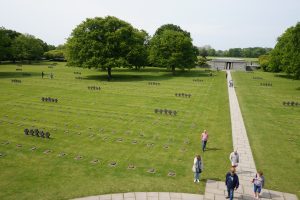Kate Greer
History and German, Class of 2020
I started learning German when I was twelve years old, and when I was sixteen, I decided I wanted to study the language for the rest of my life. Sincerely learning a language, however, means learning another culture and history as well, and while every country has its attributes it would rather forget, Germany’s struggle to come to terms with its past has always been prominent for me.
I traveled to Germany for the first time in 2014 to attend school as an American exchange student. Before my first day, my host sister was careful to explain to me that I shouldn’t talk about World War II unless it was brought up in history class. I was also not to stick my index finger under my nose in reference to a moustache, because it reminded people of Hitler. Even saying the word “Jewish” made people feel uncomfortable. I fell in love with other parts of German culture as the weeks rolled on, such as efficient public transportation, universal appreciation for art, and determination to care for the environment. But no matter how many delicious German meals I ate or World Cup games the German soccer team won, I continued to notice the inherited guilt that overcame my German friends whenever a darker part of their history was brought up. Back in America, I got serious about German Studies, and I read more and more about the anti-Semitism fostered in German culture, art, and media during the early 20th century. I discovered that Hitler did not begin anti-Semitism in Germany; he simply encouraged people to act on their deeply-rooted beliefs. I learned about the Holocaust from the perspective of the German people during and after the war, when they realized what had happened. I began to understand what the culture I had fallen in love with had, at one time, been capable of.
Even though I have been studying German language and culture for eight years, I had never been to Berlin until this year. I had read books, watched movies, seen photos, and done projects all about Berlin, but actually traveling to the German capital city, as an American German student, was one of the most profound experiences I had on this trip. Although Berlin played an important role in many historical periods, our group was there to learn about World War II through German eyes, so we went to sites such as the German Historical Museum, the German Resistance Memorial Center, the Topography of Terror, the Wannsee House, the Memorial to the Murdered Jews of Europe, the German-Russian Museum, and Cecilienhof Palace to get a better idea of this.
All of these museums laid out the events of the war as they occurred, explaining Hitler’s ascent to power, the German takeover of Europe, and the Holocaust. In the German Historical Museum, the Jewish people were given their own section of an exhibit with the same sculpture of a crematorium full of murdered people that we saw at Auschwitz. In the German Resistance Memorial Center, one placard informed guests that the members of the resistance movements were the vast minority of citizens at the time; almost all other Germans were okay with Hitler’s accumulation of limitless power. The Topography of Terror also detailed ways in which Germans would terrorize each other in a struggle to stay on top in the Third Reich. Although these recollections didn’t seem to answer why almost everyone in Germany supported the Nazis or why they stood by while their Jewish comrades were murdered, they did demonstrate honesty in the narrative of their country’s brutal history, which wasn’t always the case in France or Poland.
As an American German student, I am proud of my second home country for being determined to tell their nation’s history, no matter how difficult and shameful it is. As an American history student, I can see that they still have a long way to go in accepting the magnitude of support for policies and ideologies that almost wiped out an entire race of people. And as an American, I hope that my country can follow in Germany’s footsteps and improve the way we present our history, which is also full of bloody war, discrimination, and genocide. Coming to terms with the past and vowing to never repeat the terrible mistakes of our ancestors is a long process, but I hope that America and Germany, two countries that I love, can brave that journey towards honesty, understanding, and healing together.























